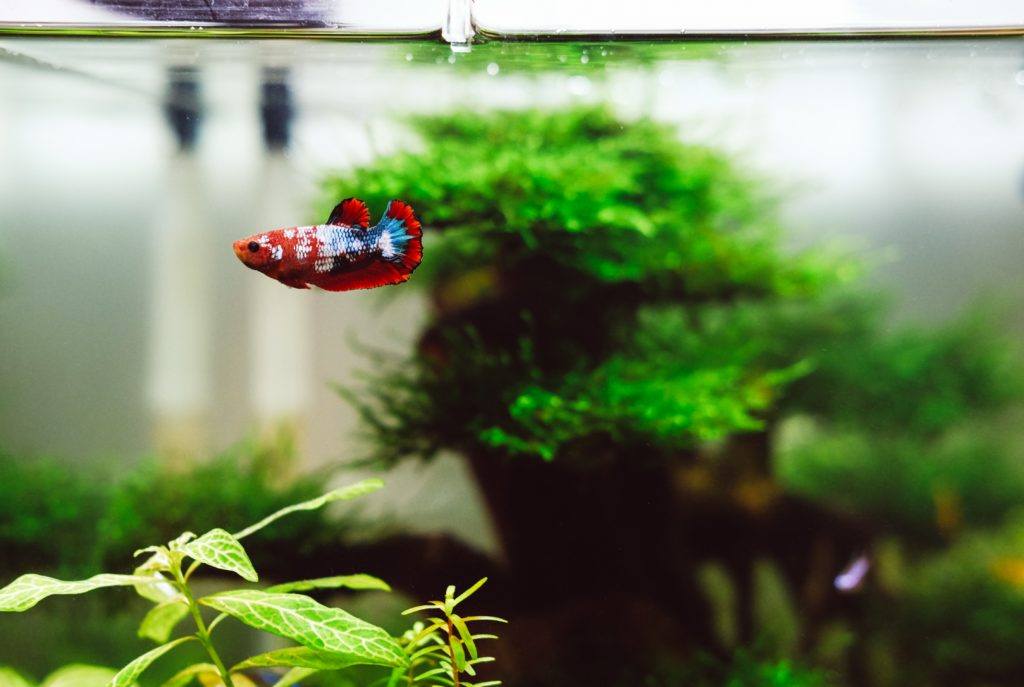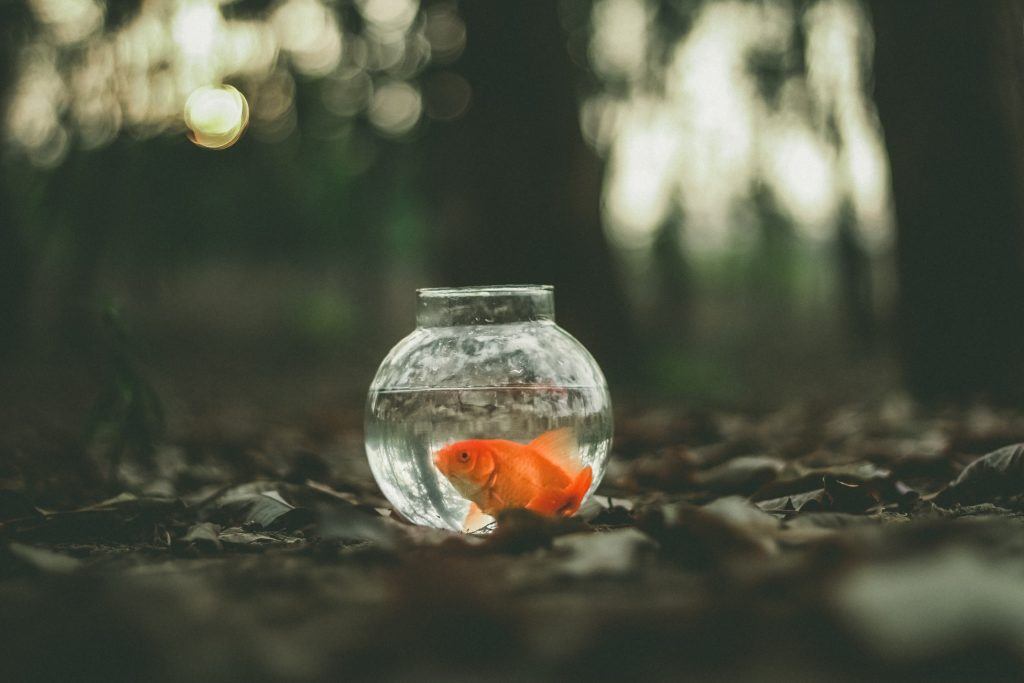When you’re preparing yourself for your first fish, tank sizes may prove challenging to understand. Some appear unnecessarily flashy, while others are overly plain.
Do you need a massive aquarium, or will a typical goldfish bowl do? What factors go into the sizing of your tank? How should you maneuver through different types of tanks?
Developing an understanding of fish tank sizes is easier than you may think, though it does require careful and thoughtful research of your own.
Contents
Choosing Fish Tank Size by Occupants
Before you go out and purchase a tank at random, you will want to consider your future occupants. What kind of fish do you want to have? What kind of needs do those fish have?
If you plan on having fish from different breeds, how will those fish interact with one another, and how much space will they need in order to feel comfortable in their new home?
Below are three different examples of fish that require three fairly different environments in order to live happily.
Goldfish
First, let’s consider the goldfish. This well-known breed has appeared in all sorts of media, thereby skewing how a potential fish owner may believe they should take care of their new pet.
Contrary to media presentation, which leaves goldfish in a relatively small, round bowl, goldfish require a significant amount of space in order to thrive. That’s because goldfish can grow to be surprisingly large.
Their size is also somewhat difficult to predict. It’s most commonly understood that a goldfish should stay between one and two inches in length; however, these fish have also been reported to have reached six inches in length when kept in a tank and cared for properly.
Wild goldfish, comparatively, can grow to be twelve to fourteen inches in length – over a foot long. This sizing versatility makes it a little difficult to predict what size of tank you will need for your new friend.
At the smallest, though, you should invest in a tank that contains at least twenty gallons of water and that is three feet in length. For every additional goldfish you bring into your school, you’ll want to increase your tank’s size by ten gallons.
Keep in mind, also, that goldfish in particular only do well with other goldfish. So, you won’t have to worry about tank diversity when you adopt them, but you will eventually have to worry about the care and keeping of a rather sizable school.
Pygmy Gourami
Big fish tanks, like the ones you should seek out for goldfish or other sizable fish, aren’t so hard to find, but they’re absolutely necessary in order to preserve a fish’s health.
Small fish tanks, on the other hand, are often misused for these larger fish. A smaller fish tank is more ideal for a fish such as the pygmy gourami.
This smaller breed doesn’t grow any larger than one and a half inches in length and require, at a minimum, five gallons of water to swim around in.
These fish also need access to air, as they only get some of their necessary oxygen from the water in which they live.
Considered relatively easy to take care of, a pygmy gourami would be ideal as a pet to keep in a college dorm room or a smaller, urban apartment, so long as the tank has an appropriate amount of foliage for the fish’s comfort.
Since pygmy gourami are also relatively mellow fish (though the males are notably more aggressive than the females) they don’t need the same kind of space as goldfish to establish themselves comfortably.
All the same, these fish deserve a reasonable amount of water to maneuver through in order to maintain their health.
Bettas
What about betta fish, though? The jury is out on what kind of tank is ideal for this breed of fish, but they do pose an interesting conundrum.
Betta fish, or Siamese fighting fish, are reasonably small; they tend to stay around three inches in length. Based on this general size, a future betta owner might assume that a betta could be kept in a small-to-medium sized tank.
However, bettas are also notoriously aggressive. It’s advised that future betta owners keep them as singular pets; males, in particular, are known to consume other breeds of fish without qualm. Female bettas, on the other hand, can live peaceably together in large schools.
You’re probably wondering, “How big of an aquarium do I need to house a betta, then?”. This varies by the gender of the betta you bring home as well as by the number of bettas you’d like to have.
A singular male betta will thrive in a tank that is between eight and fifteen gallons, so long as the tank has plenty of stimulating goodies sprinkled throughout it.
A larger collective of female bettas, comparatively, will need a tank that is between ten and twenty gallons in capacity, if not bigger.
Remember: for every additional fish you bring into your tank, you will want to increase the tank’s size by five to ten gallons.
Fish Tank Sizes for Mates and Breeding
It is also worth noting your intentions for the fish you bring into your home or office. If you intend to have the fish you adopt breed, then you’ll not only plan your tank size around the two fish who you’d like to mate, but also around the eggs that will eventually hatch and produce more tank residents.
Breeding fish should find themselves at home in a spawning tank. On average, a spawning tank should have a water capacity of between ten and twenty gallons. Larger fish, however, will need significantly larger spawning tanks.
However, here you run the risk of oversizing your tank; if the spawning tank you purchase is too large for your fishy friends, then it will be more difficult for you to keep track of fish eggs and future fishy residents. It is also important that your spawning tank comes with a well-sealed lid.
Fish owners don’t typically assume that their fish will try to throw themselves out of their tanks, but when stimulated by the instinctive urge to breed, certain fish may find themselves more enthusiastic than others, and end up leaping out of their watery homes.
Again, do significant research on the breed of fish you are bringing into your home before purchasing your tank. Each breed requires a different sort of care, and you’ll want to ensure that you do everything you can to keep them healthy.
Available Fish Tank Sizes
That said, a tank’s size may vary based on what said aquarium is specialized for.
There are a number of more unique tanks for future fish owners to choose from with qualities that differ based on the owner’s intentions.
Standard Tanks
Your average aquarium comes with few perks. It will have a lid that fits well, and runs between two and fifteen gallons in capacity.
Typically, these tanks will be made out of glass or acrylic, both of which may need to be cleaned over time.
Fish for small tanks often do well in a standard tank. A jaunt into your local pet store will expose you to a number of standard tanks; so long as you’ve done your research, you should be able to pick the one that is the right size for your preferred breed.
Show Tanks
Show tanks are considered to be of better quality than a traditional aquarium.
They have lids that will resist even the jumpiest of fish and a number of filter slots that will make it easier for you to ensure the cleanliness of the tank.
These are also ideal for customization; should you have filters from previous tanks that you’d like to use again, or should you be particularly fond of one brand of filter, show tanks will ensure that you can fit these accessories in as you please.
Long Tanks
Long tanks are, as the name implies, long. Their surface area finds most of its gumption in its horizontal length, meaning that such a tank is likely to stretch out over a desk or counter top with ease.
These tanks don’t have any particular accessory benefits, but some fish, larger fish, for example, prefer having the additional room to swim in.
Tall Tanks
Comparatively, tall tanks find the bulk of their surface area in their vertical height.
These fit more effectively into confined spaces; they won’t take up the whole of a desk, for example, though they may be as tall as your bedroom or office wall.
Fish tank dimensions, again, depend on the fish you’d like to adopt; if you have a fish that prefers to travel vertically as opposed to horizontally, then a tall tank is ideal for you.
Spawning Tank
Spawning tanks, as has already been mentioned, are tanks meant for fish that you intend to breed.
These tanks often have separate, specialized areas for fish to lay their eggs in, and their size enables you to keep better track of your new residents as they hatch.
Here’s a video explaining more on fish tank sizes.
Final Thoughts
In preparing to purchase a fish tank, it is essential that you keep the comfort of your ideal breed of fish in mind.
Measure out the carrying capacity of your future tank and ensure not only that it’s suitable for your fish, but that you have enough room to comfortably fit the tank among your things.
Consider, as well, that there are several other factors that go into the care and keeping of fish beyond the size of the tank that they live in.
Water hardness, chemical balance, and foliage or stimulation all help to ensure that your fish are as healthy and happy as possible.




